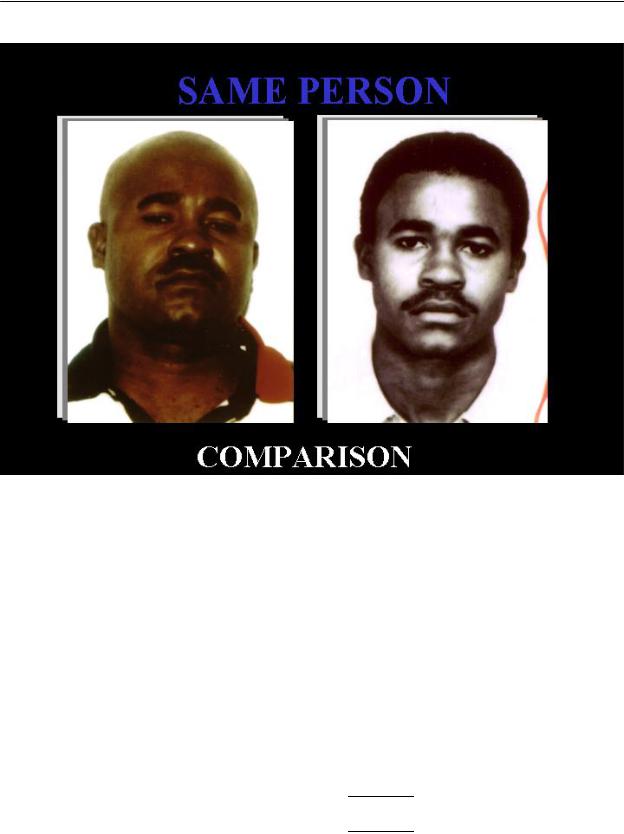
English fo MP student book
.pdf
UNIT 1 – Descriptions
¾ Activity 9
Try to describe the two persons photographed here
What are the most important distinguishing features for each?
¾ Activity 10
Identify and correct the mistakes in each sentence
1.He is long brown hair.
2.She has a freshly complexion.
3.He is average high.
4.She has dark brown dyed hair.
5.He is blue eyes.
6.He is a tattoo on his right forearm.
7.The suspect was casual dressed.
8.He is known to associate with drug addictions.
9.The suspect uses heavy make-ups.
10.He is a white european.
Border police and other law enforcement officers have special training to enable them to spot imposters! Can you identify from the two photographs if it is the same man?
35

English for Modern Policing
POLICE REPORT
1. Person reporting:
Address: |
|
|
|
|
|
|
|
Age |
|
|
|
|
Sex |
|
|||
Complainant: |
|
|
|
|
|
|
|
|
|
|
|
|
|
|
|
|
|
Address: |
|
|
|
|
|
|
|
|
|
|
|
|
|
|
|
|
|
Incident as Reported |
|
|
|
|
|
|
|
|
|
|
|
|
|
|
|
|
|
Reported To: |
|
|
|
|
|
Time& Date |
|
|
|
|
|
|
|||||
2.Where Committed |
Name of premises |
|
|
|
|
|
|
|
|||||||||
House No. |
|
|
|
Street |
|
|
|
|
|
|
|
||||||
|
|
|
District or Town |
|
Month |
|
|
|
|
||||||||
3.When committed |
Time |
|
|
Day |
Date |
|
|
Year |
No.of witnesses |
||||||||
(24hrs) |
|
|
|
|
|
|
|
|
|
|
|
|
|
||||
At/ Between |
|
|
|
|
|
|
|
|
|
|
|
|
|
|
|
|
|
and |
|
|
|
|
|
|
|
|
|
|
|
|
|
|
|
|
|
|
|
|
|
|
|
|
|
|
|
|
|
|
|
|
|
|
|
If M/Vehicle Used |
|
|
|
|
|
|
|
|
|
|
|
|
|
|
|
|
|
Show Reg. No. (or Part) |
|
|
|
|
|
|
|
|
|
|
|
|
|
|
|
|
|
36

UNIT 1 – Descriptions
Description of Suspect/Offender
Dress |
|
|
Smart |
|
|
Casual |
|
|
Sporting |
|
|
|
Scruffy |
|
|
Vagrant |
|||||||||||||
Marks |
|
|
Tattoos |
|
|
Scar |
|
|
Deformity |
|
Other |
|
|
|
|
|
|
|
|
|
|||||||||
|
|
|
|
|
|
|
|
|
|
|
|
|
|
|
|
|
|
identifying |
|
|
|
|
|
|
|||||
|
|
|
|
|
|
|
|
|
|
|
|
|
|
|
|
|
|
marks |
|
|
|
|
|
|
|
|
|
||
Enter Appropriate Code in Box Below |
|
|
|
|
|
|
|
Accent |
|
|
|
|
|
|
|
|
|
|
|||||||||||
|
Height |
|
|
Build |
|
Ethnic |
|
Hair |
|
|
|
|
Age |
|
|
|
Age Range |
||||||||||||
|
|
|
|
|
|
origin |
|
colour |
|
|
local |
|
|
|
|
group |
|
|
|
|
|
||||||||
1 |
under |
1 |
|
fat |
1 |
White |
1 |
balck |
1 |
|
|
|
|
1 |
school |
1 |
|
under 12yrs |
|||||||||||
|
1.60m |
|
|
|
|
European |
|
|
|
|
|
|
|
north |
|
|
|
|
age |
|
|
|
|
|
|||||
2 |
1.60- |
2 |
|
heavy |
2 |
Dark |
2 |
brown |
2 |
|
|
|
|
2 |
young |
2 |
|
12-13yrs |
|||||||||||
|
1.75m |
|
|
|
|
European |
|
|
|
|
|
|
|
south |
|
|
|
|
|
|
|
|
|
|
|
|
|||
3 |
over |
3 |
|
medium |
3 |
Asian |
3 |
ginger |
3 |
|
|
|
|
3 |
middle |
3 |
|
14-16yrs |
|||||||||||
|
1.75m |
|
|
|
|
|
|
|
|
|
|
|
|
|
|
Scots |
|
|
|
|
age |
|
|
|
|
|
|||
4 |
|
4 |
|
slim |
4 |
Oriental |
4 |
blonde |
4 |
|
|
|
|
4 |
old |
4 |
|
17-20yrs |
|||||||||||
5 |
|
5 |
|
thin |
5 |
Arabian |
5 |
white |
5 |
|
Welsh |
|
5 |
|
|
|
5 |
|
21-29yrs |
||||||||||
6 |
|
6 |
|
|
6 |
|
|
|
6 |
grey |
6 |
|
Irish |
|
|
|
6 |
|
|
|
6 |
|
30-39yrs |
||||||
7 |
|
7 |
|
|
7 |
|
|
|
7 |
bald |
7 |
|
foreign |
|
7 |
|
|
|
7 |
|
40-49yrs |
||||||||
8 |
|
8 |
|
|
8 |
|
|
|
8 |
dyed |
8 |
|
unknown |
|
8 |
|
|
|
8 |
|
50-59yrs |
||||||||
9 |
un- |
9 |
un- |
9 |
unknown |
9 |
un- |
9 |
|
|
9 |
|
|
|
9 |
|
60yrs& |
||||||||||||
|
known |
|
|
known |
|
|
|
|
|
known |
|
|
|
|
|
|
|
|
|
|
|
|
|
|
over |
||||
|
|
|
|
|
|
|
|
|
|
|
|
|
|
|
|||||||||||||||
Offender/Suspect Name&Address |
Reported |
|
|
|
|
|
|
|
Suspected |
|
|
|
Wanted |
|
|||||||||||||||
|
|
|
|
|
|
|
|
Sex |
|
|
|
|
|
|
|
|
|
|
DOB |
|
|
|
|
|
|
|
|
||
|
|
|
|
|
|
|
|
C.R.O.No. |
|
|
|
|
|
|
|
|
|
|
|
|
|
|
|
|
|
|
|||
|
|
|
|
|
|
|
|
|
|
|
|
|
|
|
|
|
|
||||||||||||
|
Complainant requests no publicity (Tick) |
|
|
|
|
|
|
|
|
|
|
|
|
|
|
|
|
|
|||||||||||
|
Officer in Case ……………………….. |
|
|
|
|
|
|
|
|
|
|
|
|
|
|
|
|
|
|||||||||||
|
|
|
|
|
|
|
|
|
|
|
|
|
|
|
|
|
|
||||||||||||
|
Officers Attending Scene (Officers Time and Date of Arrival) |
|
Section Officer |
||||||||||||||||||||||||||
|
Reporting Officer |
|
|
|
|
|
|
|
|
|
|
|
|
|
|
|
|
|
Plain Clothes |
||||||||||
|
C.I.D. |
|
|
|
|
|
|
|
|
|
|
|
|
|
|
|
|
|
|
|
|
Crime &Vandalism Squad |
|||||||
|
Crime Prevention |
|
|
|
|
|
|
|
|
|
|
|
|
|
|
|
|
|
Other Supervising Officer |
||||||||||
|
Others |
|
|
|
|
|
|
|
|
|
|
|
|
|
|
|
|
|
|
|
|
|
|
|
|
|
|||
Witnesses: (Name, addressnature of evidence)
Report of Investigating Officer: I have made enquiries as follows:
SCENE |
VICINITY OF SCENE |
Searched |
Local residents |
Fingerprint examination |
Tradesmen |
result awaited |
|
37

English for Modern Policing
Occupants interviewed |
|
Passers by |
Visitors |
|
Suspected persons |
Relations |
|
Suspected vehicles |
Employes |
|
Unusual telephone |
Tradesmen |
|
calls |
Others |
|
|
SEARCH OF AREA FOR |
|
|
Route taken by offender |
|
Abandoned property |
Instrument |
|
Abandoned vehicles |
ENQUIRIES TO TRACE SUSPECTS |
|
|
Places of entertainment |
|
Hospitals/surgeries |
Licensed premises |
|
Places of refreshment |
Hotels/hostels |
|
Gipsy encampments |
Observations to be kept |
|
Periodic visits |
Photographs shown |
|
Photo-fit shown |
Informants |
|
|
Liaison |
|
|
C.R.O. |
|
|
Crime Int. |
|
|
P.N.C. |
|
|
Date |
Officer |
Rank & No. |
38

UNIT 2
CRIME AND PUNISHMENT
¾ Activity 1 |
Discussion |
1.Why do we have rules and laws? Why do people follow them? Why do people break them?
2.Is ignorance of the law an excuse? Why (not)?
3.A policeman on duty kills a criminal while defending a victim? Has the officer committed any crime?
4.What is crime? Take two minutes to write a possible definition for crime.
5.There is more crime than there used to be. Do you agree? Why (not)?
6.You are innocent until proven guilty! Why do you think miscarriages of justice still occur?
7.Where can you find the following signs? What do they tell you?
|
|
|
|
|
|
|
WARNING |
|
|
|
|
|
|
|
|
|
|
||
|
|
|
|
|
|
|
NO DUMPING |
|
|
|
|
|
|
|
|
|
|
||
|
|
|
|
|
|
|
|||
|
NO |
|
|
|
|
|
ALLOWED |
|
|
|
|
|
|
|
|
|
|
|
|
|
TRESPASSING |
|
|
|
|
Perpetrators will |
|
||
|
|
|
|
|
|
|
be |
|
|
|
|
|
|
|
|
|
prosecuted |
|
|
|
|
|
|
|
|
|
|
|
|
|
|
|
|
|
|
|
$500 FINE |
|
|
|
|
|
|
|
|
|
|
|
|
|
|
|
|
|
|
|
|
|
|
|
|
|
|
|
|
|
|
|
|
¾ Activity 2
What effects do you imagine the following have had on crime?
ZONE
30
1. |
the invention of gunpowder |
6. |
war |
2. |
the creation of police |
7. |
the discovery of fingerprints |
3. |
street lighting |
8. |
cars |
4. |
employment in factories |
9. |
the colour of man’s skin/religion |
5. |
the payment of police |
10. the welfare state |
|
39

English for Modern Policing
¾ Activity 3
Look at the “spidergram” below and say what effect each of these factors has on the crime rate and why.
|
|
|
|
|
|
|
Alcoholism/ |
|
|
|
|
|
|
|
|
|
|
|
|
|
|
||
|
|
|
|
|
|
|
drugs |
|
|
|
|
|
|
|
|
|
|
|
|
|
|
|
|
|
|
|
|
|
|
|
|
|
|
|
|
|
Severity of |
|
|
|
|
|
|
|
|
Social values |
|
|
punishment |
|
|
|
|
CRIME |
|
|
|||
|
|
|
|
|
|||||||
|
|
|
|
|
|
|
RATE |
||||
|
|
|
|||||||||
|
|
|
|
|
|
|
|
|
|
|
|
|
Individual |
|
|
|
|
|
|
|
|
|
Police/other |
|
morality |
|
|
|
|
|
|
|
|
|
prevention |
|
|
|
|
|
|
|
|
|
|
|
|
|
|
|
|
|
|
|
Poverty |
|
|
|
|
|
|
|
|
|
|
|
|
|
|
|
|
|
|
|
|
|
|
|
|
|
|
|
|
|
|
|
|
|
|
|
|
|
|
|
|
¾ Activity 4 |
Writing |
Crime is on the increase. Offer some possible solutions. Use the following phrases in an essay of around 200 words.
It is my firm belief that...
One way to combat crime would be...
The result of this would be ...
Furthermore...
Due to the fact that...
A further advantage of this...
On the other hand...
It would certainly be a good idea if ...
One final suggestion...
¾ Activity 5 |
Crimes |
Preliminary Acts as Crimes
Read the following text and choose the best word for each space.
Certain types of behaviour take place before the ……1……of a crime but are nevertheless complete crimes in……2….. These offences – solicitation, attempt and conspiracy – give the police the opportunity to prevent the intended crime. Each offence can be punished even if the ……3….intended never occurred.
A number of states make …4….. a crime for a person to solicit (ask, command, urge, advise) another person to commit a crime.
In most states an attempt to commit a crime is in itself a crime. To be guilty of the crime of attempt, the accused must have ……5….intended to commit a crime and taken some substantial …6….toward committing the crime. …7……preparation to commit a crime is not enough. The difficult problem with the crime of attempt is determining ……8….the actions of
40

UNIT 2 – Crime and Punishment
the accused were a step toward the …9…..commission of a crime or mere acts of preparation. A common example of attempt is the situation in which a person decides to shoot and kill someone but, being a poor…10……., misses the intended victim. The person doing the shooting would be ……11…for attempted murder.
A conspiracy is an agreement between two or more persons to commit a crime. The crime of conspiracy is designed as a means of preventing other crimes and ……12…against criminal activity by groups. ……13…..it is sometimes criticised as a threat to freedom of speech and association.
1. a) commission |
b) achievement |
c) accomplishment |
d) finalisation |
2. a) them |
b) itself |
c) they |
d) themselves |
3. a) bad |
b) harm |
c) wrong |
d) worse |
4. a) it |
b) this |
c) - |
d) of |
5. a) also |
b) both |
c) too |
d) still |
6. a) way |
b) possibility |
c) step |
d) action |
7. a) little |
b) just |
c) a few |
d) mere |
8. a) when |
b) that |
c) whether |
d) therefore |
9. a) actual |
b) current |
c) existing |
d) present |
10. a) man |
b) guy |
c) killer |
d) shot |
11. a) accused |
b) liable |
c) sentenced |
d) exonerated |
12. a) striking |
b) urging |
c) beating |
d) interrupting |
13. a) despite |
b) although |
c) however |
d) as well |
¾ Activity 6 Crimes Against the Person
Crimes against the person are serious offences. However the law protects the defendant by defining the various levels of these crimes and by considering the circumstances of each offence.
Using dictionaries and working in pairs, give definitions to the following crimes.
assault, battery, homicide, murder, first-degree murder, second-degree murder, voluntary manslaughter, grievous bodily harm,
involuntary manslaughter, abduction, slander, libel, hate crime
Share your results with the class. One has been done for you.
Hate crime is defined as "the violence of intolerance and bigotry, intended to hurt and intimidate someone because of their race, ethnicity, national origin, religion, sexual orientation, or disability.”
(Community Relations Service, 1997)
N.B. In the texts, some of the crimes are specific to the American legal system, some to the English. The two systems have different terminology, the more serious crimes in the US system are called felonies and the less serious are called misdemeanors. There are different terms for specific crimes, too, e.g. larceny (US) is divided into petty and grand. In English law, the crime is theft.
41

English for Modern Policing
¾ Activity 7 Crimes Against Property
Use the words in the box to complete the text.
arson burglary computer crime embezzlement extortion forgery theft mugging receiving stolen property robbery shoplifting taking a vehicle without consent vandalism
The category of crimes against property includes crimes in which property is damaged or cases in which property is stolen or otherwise taken against the will of the owner.
a)… is the willful and malicious burning of another person’s property, whether owned by the accused or not. If any property is burned with the intent to defraud an insurance company this is usually a separate crime.
b)… also known as malicious mischief, is the willful destruction of, or damage to, the property of another. It includes such things as smashing telephone kiosks, breaking windows, ripping down fences, flooding basements and breaking car aerials. Depending on its extent, it can be either a felony or a misdemeanor in the USA.
c)… is the unlawful taking of property of another with intent to steal it permanently. This crime also includes keeping lost property when a reasonable method exists for finding the owner, or if you keep property delivered to you by mistake..
d)… is a form of theft (or larceny in US). It is the crime of taking items from a store without paying or intending to pay for them.
e)… is the unlawful taking of property or money by someone to whom it was entrusted. IN UK it is a form of theft.
f)… is the unlawful taking of property from a person’s immediate possession by force or intimidation, generally in banks, trains etc. In fact, it involves two criminal intentions: theft of property and actual or potential physical harm to the victim
g)…, popularly called blackmail, is the use of threats to obtain the property of another. Its statutes generally cover threats to do future physical harm, destroy property or injure someone’s character or reputation.
h)…, originally defined as breaking and entering the dwelling of another during the night with intent to commit a felony (commit theft –UK), now includes the unauthorised entry into any structure with the intent to commit a crime, regardless of the time of day.
i)… is a crime in which a person falsely makes or alters a writing or document with intent to defraud. It can also mean altering or erasing part of a previously signed document.
j)… is a crime of receiving or buying property that you know or have reason to believe is stolen. Knowledge that the property is stolen may be implied by the circumstances.
k)… is committed when a person takes, operates, or removes a motor vehicle without consent of the owner, including joy-riding. A passenger in a stolen car may also be guilty if that person had reason to believe the car was being used without permission.
l)… can be broadly defined as the unauthorised access to someone else’s computer system. Most of the time such action is designed to steal government or trade secrets and sell them to business rivals or foreign governments.
m)… is attacking and violently robbing a person out of doors (e.g. in a park, in a car park or in the street).
42

UNIT 2 – Crime and Punishment
¾ Activity 8
Work with a partner and test each other. One person turns the page over, the other asks questions.
e.g. What do you call the crime of burning another person’s property? Define ‘forgery’.
“Thief” is a very general term. Write more specific names for a thief in each space.
THIEF
|
|
|
|
|
|
|
|
|
|
|
|
|
|
|
|
|
|
|
|
|
|
|
|
|
|
|
|
¾ Activity 9 |
Listening |
|
||||
Listen and complete the sentences below with a word, phrase or number.
Car theft accounts for 1)……….. of all crimes.
Methods include 2)………………. and equipment, and installing 3) ……………..
Neighbourhood Watch schemes help preventing 4)……………. and thefts. Crime Concern was established in 5) …………………
In inner city areas the risk of burglary is 6)…………. than in rural areas.
Mass shootings have resulted in a review of regulations controlling 7)………………..
The problem of “drinking and driving” is combated by measures such as 8)…………….
Racial incidents consist in 9)…………………..and 10)……………….. in shops.
¾ Activity 10 |
Crime and the Media |
Explain and rewrite the headlines in detail.
4 bodies found in Camden County house; 6 arrested in drug raid nearby Student kidnap case against bus driver on hold for mental review
Two arrested in woman's slaying Search on for gunman in triple-killing
43

English for Modern Policing
Robbery suspect takes hostages at California bank
Gunman Kills 2 Men; Mother, Unborn Baby Shot
Articles Hurt Search For Yates' Jurors
Life Or Death For Deputy Killer?
Five Killed In Murder-Suicide
¾ Activity 11 |
Quiz |
•Among people victimized while working, men are more likely than women to experience a violent crime. True or false?
•Which of the following methods is more likely to be used for killing a person? Why?
a) shooting b) hitting or kicking c) sharp instrument d) strangulation e) other
•Who among the following is least/most likely to kill you? For what reasons?
a) a friend or acquaintance |
b) a present or former spouse or lover |
c) another member of |
your family |
d) a stranger |
e) a terrorist |
•More women than men are found guilty of shoplifting. True or false?
¾ Activity 12 |
Crime Fixation |
We all tend to be cynical about tabloid media sensationalism, but do you realise just how much your perceptions of crime have probably been distorted? Take a look at the table below and then discuss on it with a partner.
Perception
“Violent crime accounts for roughly a half of all crime” (average estimate in public responses to NOP poll).
“Young children and the elderly are the most at risk from violent attack”.
25% of people expect to fall victim to violent crime.
“It’s dangerous to be out on the streets after A greater number of violent attacks take place in
dark”. |
the home than on the street. |
85% of adults believe it’s more dangerous |
Over the last 25 years there has been no increase |
for children after dark now than when they |
in child murder by strangers. The overall murder |
were young. Attack by strangers is the |
rate (all age groups) has been almost static over |
biggest fear (survey by Dr Barnardo’s |
the last 10 years. |
children’s welfare agency). |
|
44
